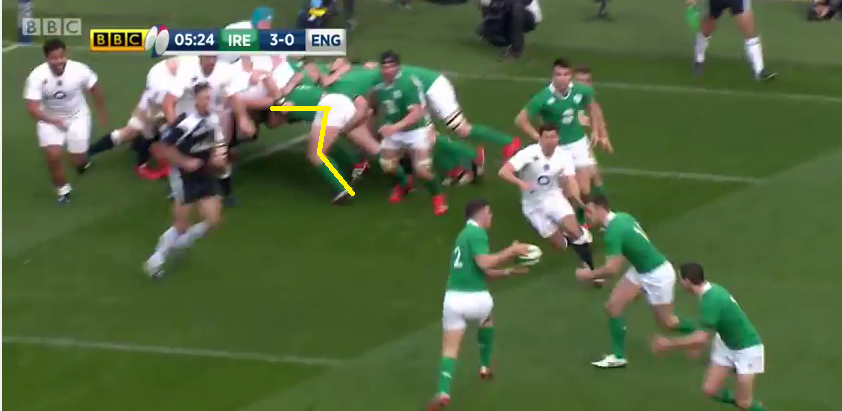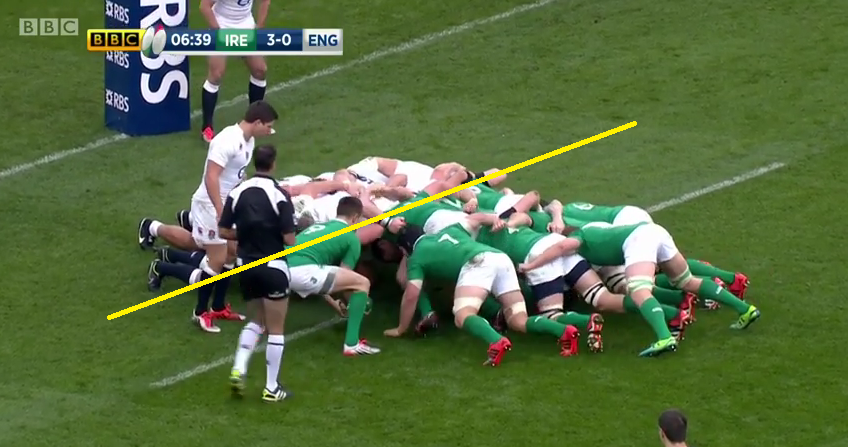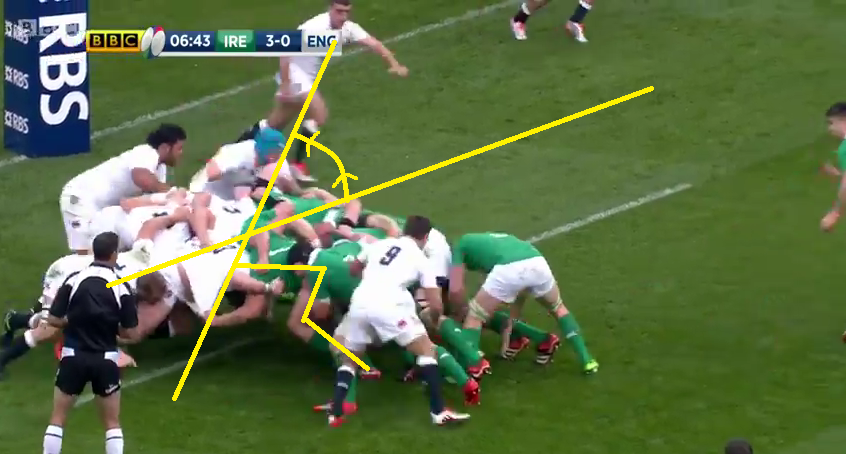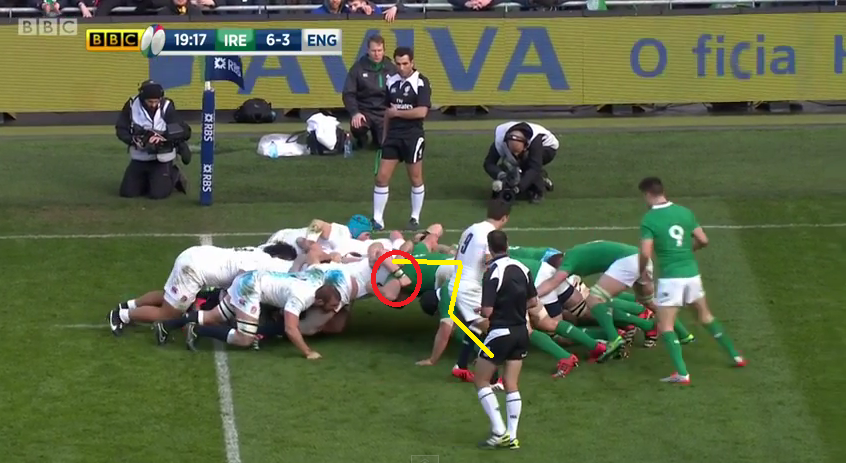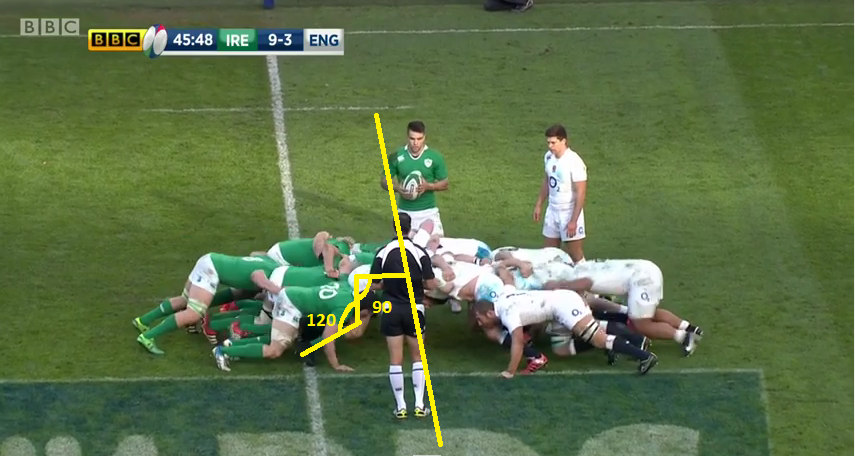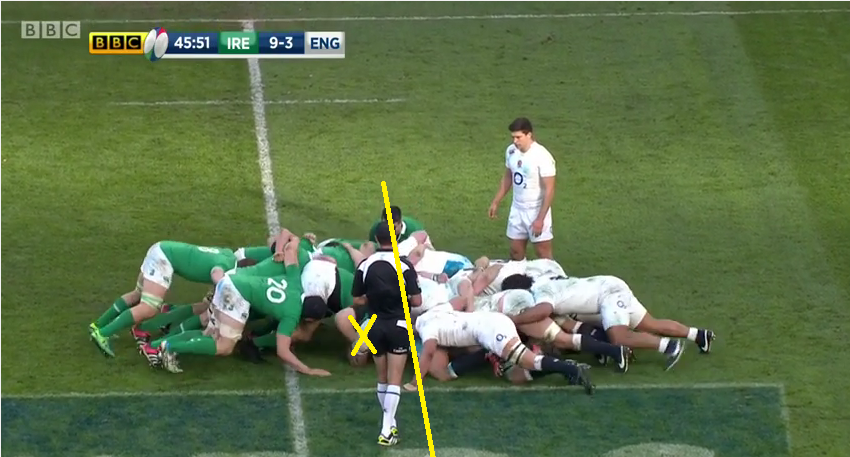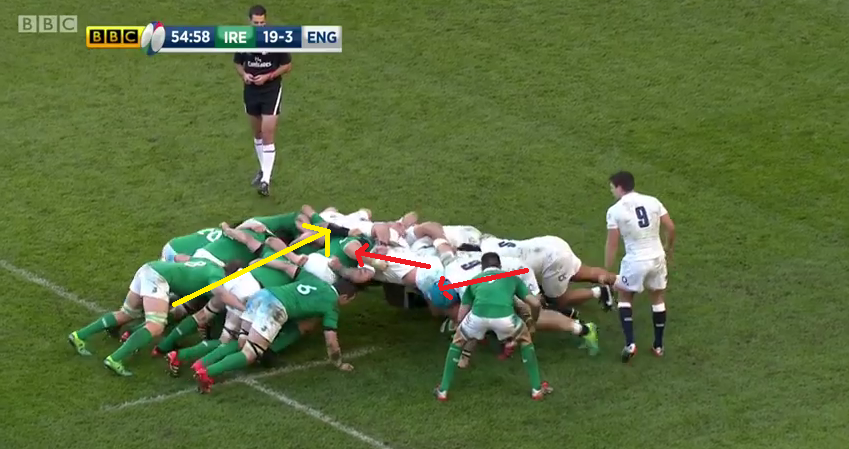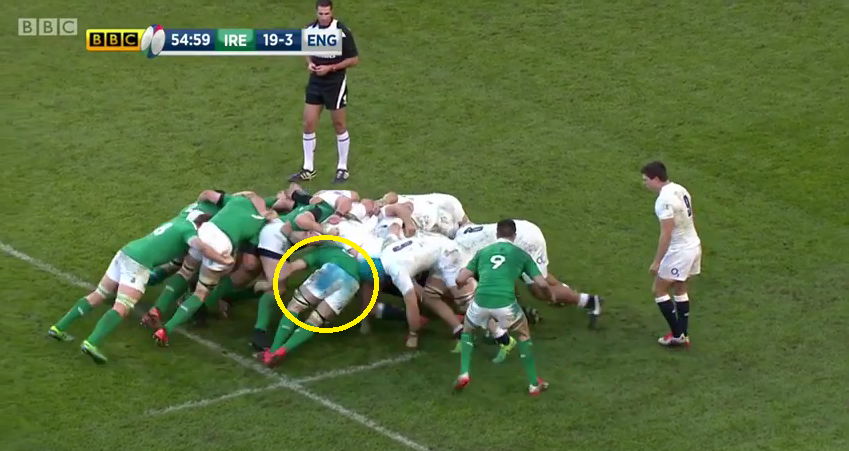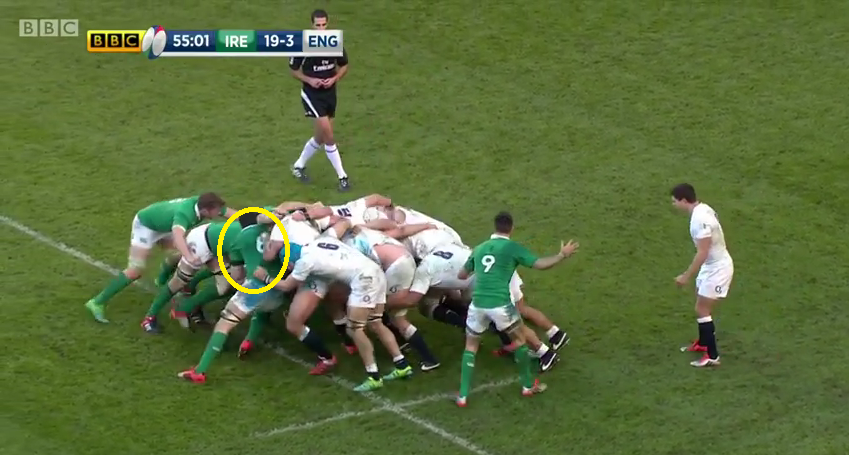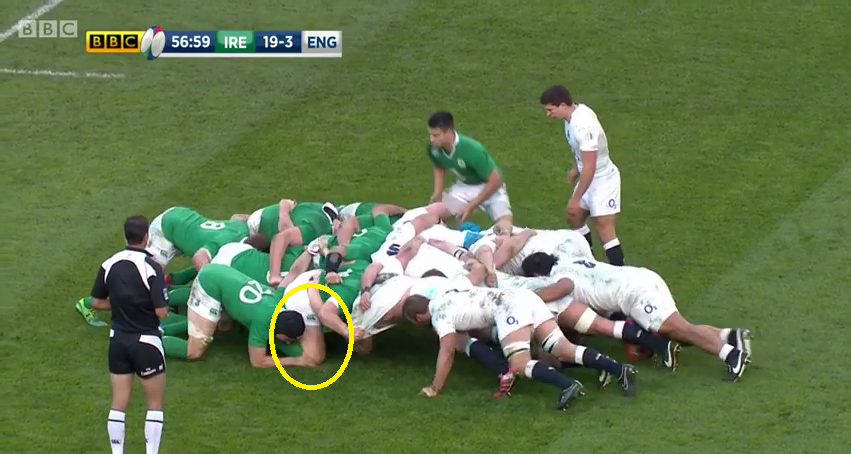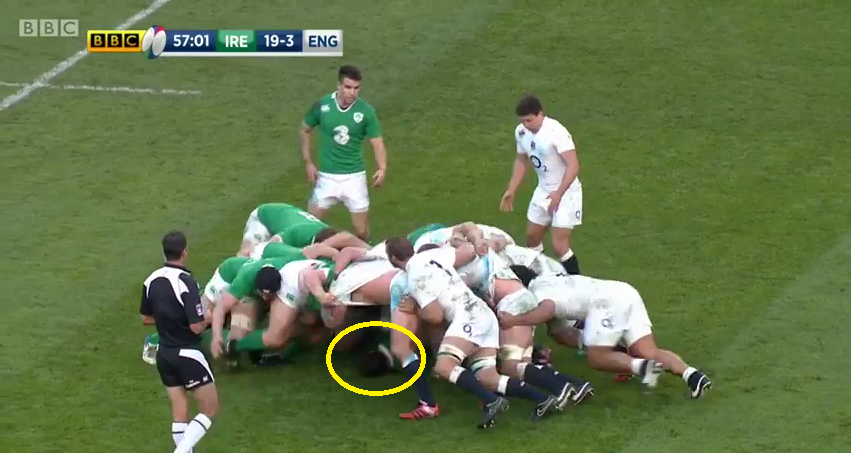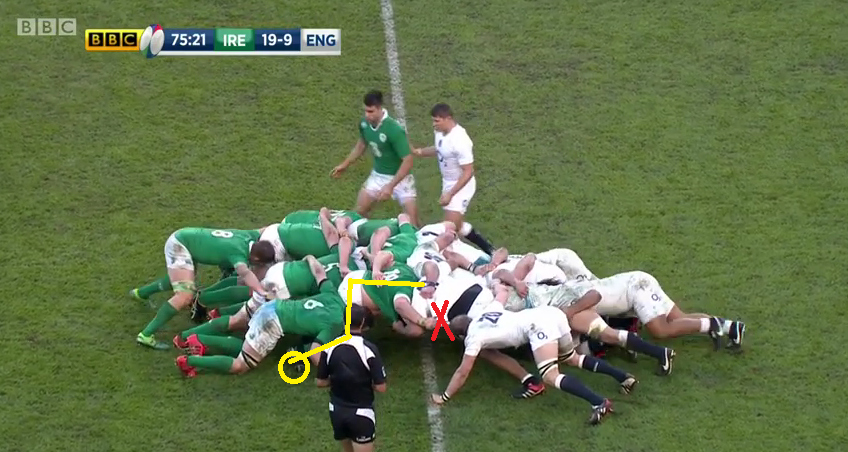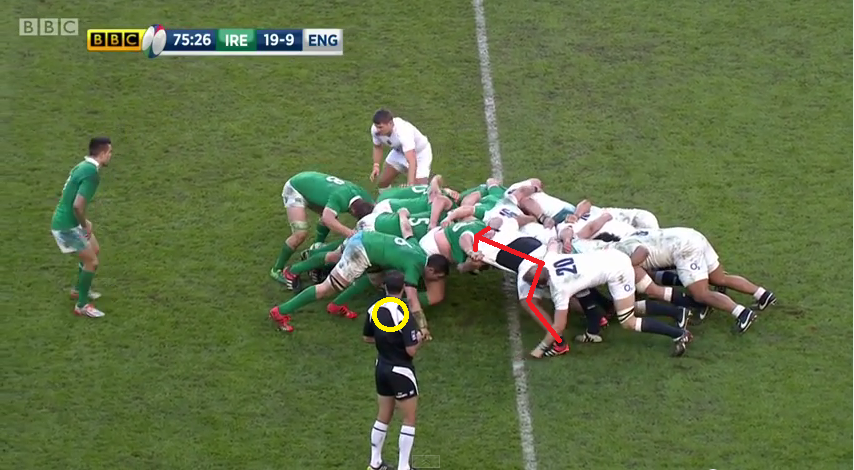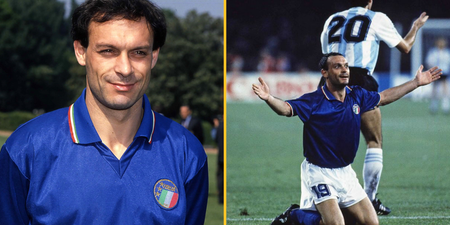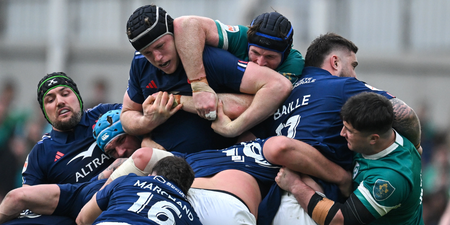On Sunday, less was more.
“Winning” the scrum battle was going to be key, but for Ireland – with Joe Marler’s history against Mike Ross – simply not losing that battle would be as good as a victory.
After running into trouble against France, the Irish scrum went back to basics on Sunday, and for the most part the basics were done right.
Strangely, Ireland’s scrum performance was a 15 man effort on Sunday.
While it was the front eight that had to pack down, the full team played their part, limiting errors and ensuring that if there was going to be a lot of scrums, it was Ireland who would have the put in.
Indeed, Ireland allowed England a put-in to just one scrum in the entire game, while three of the first four scrums of the day were a direct result of successful Irish kick chases.
The opening drive was an indication of Ireland’s intent.
Put the ball in, and get it out.
One part of this scrum I want to look closer at, though, is Jack McGrath.
In the photo below, with the ball already out in the backline, it is clear that the main focus for the Irish scrum was to not go back, rather than go forward.
We can see how Jack McGrath has a very wide stance, and has his weight planted firmly on his front studs, ensuring he’s able to manoeuvre effectively, should Dan Cole get the nudge on.
Ireland had the ball in and out of the first scrum so quickly that it was difficult to analyse much.
Shortly after, however, some excellent work from Mike Ross brought about an early try-scoring chance for Ireland.
We will begin by looking at the initial set-up of the scrum. Note the yellow line running through the centre of the set-piece.
When Conor Murray feeds the ball however, the Irish shove is calculated.
McGrath acts as the anchor, holding his side of the scrum in place while Ross goes to work.
Ross then begins to gain ground on Marler, nudging his side of the scrum forward a metre or two.
The result of this is that Ireland can now effectively take scrum-half Ben Youngs out of the game for the next phase, as well as keeping James Haskell further back from Jordi Murphy and Murray, allowing them greater space to attack.
Two phases later, Johnny Sexton was tapping over a penalty to make it 6-0.
Ireland gave away a needless free-kick on their next scrum, as McGrath was penalised for an early engage.
After the first set-down collapses, Craig Joubert’s touch judge, who is keeping an eye on McGrath’s side of the scrum, has a word with his referee.
Straight afterwards, Joubert relays the message to both Dan Cole and McGrath: “No pre engage”.
McGrath does not listen.
He was lucky not to concede a penalty on the next scrum, after angling in on Dan Cole.
In this photo, we can see the pair just after the ball has been put in. Both players are straight and square, although Cole’s bind is very close to the arm.
However, as the ball makes its way back through the scrum, McGrath begins to turn inwards, driving Cole towards the touchline.
Joubert misses it, and Ireland retain possession.
Ireland’s best spell came in the two scrums after half-time, picking up a scrum, a free kick and a penalty, with Ross getting the better of Marler on both occasions.
The English loose-head was clearly frustrated at not being able to move Ross in the opening half, and he let his eagerness get the better of him.
We’re going to look at the positioning of Ross when he engages on this scrum though.
Angles are vital for propping, and the guideline is that the angle at your hips should be 90 degrees, while the angle at your knees should be somewhere in the region of 120.
We have drawn a line down the centre of this scrum, as a guideline to judge the early drive.
In the photo below, we can see that Marler has tried to drive on Ross before the ball is fed, resulting in a collapse.
We can see below that when he does drop, he has advanced a yard beyond the midpoint of the scrum. An easy free-kick for Joubert to award.
Back slaps
Ross got plenty of slaps on the back after the next scrum, and they were richly deserved.
He won a penalty after Marler’s angled drive, and again it was all down to Ross’ body position.
Below we can see just how different the two players are positioned; Ross has his 90 and 120 degree angles perfectly formed, while Marler is all over the place.
He’s driving in and up, while his legs are virtually locked out, showing just how much difficulty he’s having to move Ross.
However, some poor thinking from Peter O’Mahony could easily have resulted in Ireland conceding a penalty.
Seeing that Marler is moving in at an angle on Ross, O’Mahony shifts up side-by-side with his prop, and drives in on Marler.
While a flanker is allowed to drive at any angle to the scrum, he must have one full arm bound to the second row at all times, and as we can see from the photo below, at best, he is just about holding Paul O’Connell’s jersey with his hand.
The penalty went Ireland’s way this time for the original crooked drive from Marler, but it would not be long before O’Mahony’s trick came back to haunt him, when England had their first and only put in to a scrum in the 55th minute.
Similar to last time, it began as Joe Marler drove in at an angle on Ross.
Note the different directions that Marler and his flanker, James Haskell are driving.
Again, sensing the danger, O’Mahony shifts up.
While he remained someway bound to the previous scrum, he completely detaches himself this time around, blatantly diving into Marler in a bid to collapse him, an incredibly dangerous thing to do.
His tactic backfired on him though. Far too consumed with disrupting Marler, O’Mahony eventually even turned his back to the scrum altogether, and it’s at this point Joubert extends his arm to award England the advantage.
With O’Mahony occupied by the front row, he was slow to react on defence, and it’s one of the key reasons that Billy Vunipola made so many yards as he broke from the base.
It was a sign that the previously stable scrum was beginning to tire. With Marler beginning to turn the screw, and his body, on Ross, Joe Schmidt sent on Marty Moore to bring some energy to proceedings.
However, his first contribution to the game was a forgettable one.
He dropped the scrum, as shown, as soon as Murray fed the ball. Added to that, the Irish scrum was going backwards.
He got back to his feet, but the scrum went down again, and, again, it was the fault of an Irishman.
It is difficult to make out as we only have this angle to work with, but as the scrum caves in from the far side, it does appear to be McGrath who falls. A fair call from Joubert.
The below photo really does show just how dangerous the scrum can be though. Circled is the head of McGrath, lying helplessly as seven or eight bodies are about to fall on his neck.
Despite a rocky beginning, Moore’s final two scrums were exceptional, and being in the final 10 minutes, it was vital that they were.
Here, we can see that he has got his body angles nailed on, providing the perfect stable base.
And with England getting desperate, Cole resorts to second guessing Murray’s put in. A crucial free-kick for Ireland.
The final scrum of the game could well have been a penalty to Ireland, and, again, it owed a lot to some strong body positioning from Moore.
The initial set-up is as it should be, with his angles spot on.
But in the coming photos, keep an eye on his footwork.
With Moore not for budging, Mako Vunipola tries to hinge the scrum, which involves raising and dropping his body at the waist, in a bid to force his opponent to collapse.
First, he drops his body, but Moore’s positioning, with the front of his feet planted firmly in the ground, keeps the scrum up.
And when Vunipola lifts himself back up, Moore’s discipline has remained intact.
He was not for budging.
Bar one or two glitches, Ireland executed the basics well on Sunday.
In the French game they were much more aggressive, and it was a tactic that ultimately backfired.
For Ross, Sunday was redemption. The 35-year-old may not have much left in the tank, but at least we are beginning to find out that when he does eventually depart the international set-up, there’s a worthy heir to the Number 3 jersey.

